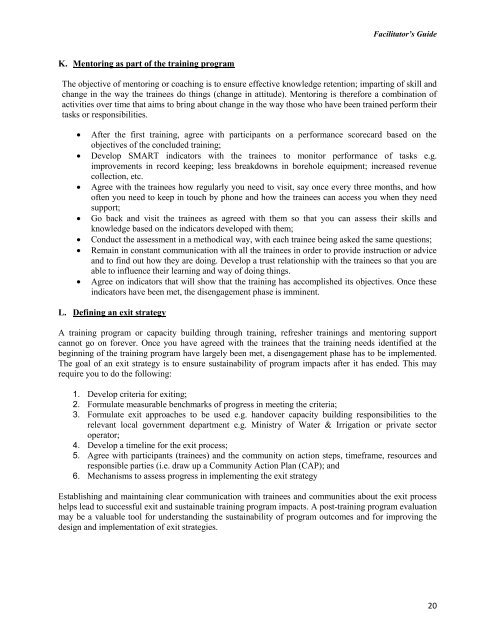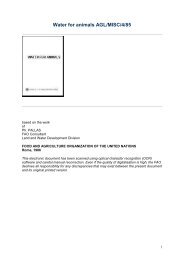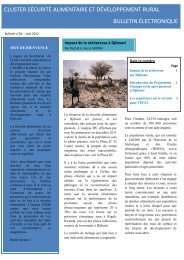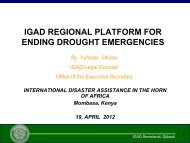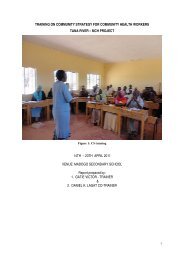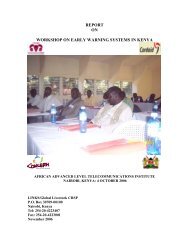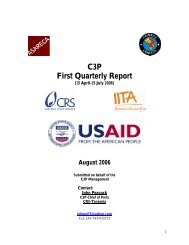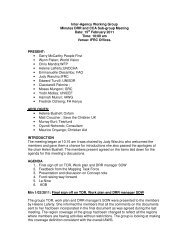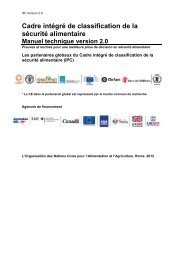A TrainerÕs Manual for Community Managed Water Supplies in Kenya
A TrainerÕs Manual for Community Managed Water Supplies in Kenya
A TrainerÕs Manual for Community Managed Water Supplies in Kenya
- No tags were found...
You also want an ePaper? Increase the reach of your titles
YUMPU automatically turns print PDFs into web optimized ePapers that Google loves.
Facilitator’s GuideK. Mentor<strong>in</strong>g as part of the tra<strong>in</strong><strong>in</strong>g programThe objective of mentor<strong>in</strong>g or coach<strong>in</strong>g is to ensure effective knowledge retention; impart<strong>in</strong>g of skill andchange <strong>in</strong> the way the tra<strong>in</strong>ees do th<strong>in</strong>gs (change <strong>in</strong> attitude). Mentor<strong>in</strong>g is there<strong>for</strong>e a comb<strong>in</strong>ation ofactivities over time that aims to br<strong>in</strong>g about change <strong>in</strong> the way those who have been tra<strong>in</strong>ed per<strong>for</strong>m theirtasks or responsibilities.After the first tra<strong>in</strong><strong>in</strong>g, agree with participants on a per<strong>for</strong>mance scorecard based on theobjectives of the concluded tra<strong>in</strong><strong>in</strong>g;Develop SMART <strong>in</strong>dicators with the tra<strong>in</strong>ees to monitor per<strong>for</strong>mance of tasks e.g.improvements <strong>in</strong> record keep<strong>in</strong>g; less breakdowns <strong>in</strong> borehole equipment; <strong>in</strong>creased revenuecollection, etc.Agree with the tra<strong>in</strong>ees how regularly you need to visit, say once every three months, and howoften you need to keep <strong>in</strong> touch by phone and how the tra<strong>in</strong>ees can access you when they needsupport;Go back and visit the tra<strong>in</strong>ees as agreed with them so that you can assess their skills andknowledge based on the <strong>in</strong>dicators developed with them;Conduct the assessment <strong>in</strong> a methodical way, with each tra<strong>in</strong>ee be<strong>in</strong>g asked the same questions;Rema<strong>in</strong> <strong>in</strong> constant communication with all the tra<strong>in</strong>ees <strong>in</strong> order to provide <strong>in</strong>struction or adviceand to f<strong>in</strong>d out how they are do<strong>in</strong>g. Develop a trust relationship with the tra<strong>in</strong>ees so that you areable to <strong>in</strong>fluence their learn<strong>in</strong>g and way of do<strong>in</strong>g th<strong>in</strong>gs.Agree on <strong>in</strong>dicators that will show that the tra<strong>in</strong><strong>in</strong>g has accomplished its objectives. Once these<strong>in</strong>dicators have been met, the disengagement phase is imm<strong>in</strong>ent.L. Def<strong>in</strong><strong>in</strong>g an exit strategyA tra<strong>in</strong><strong>in</strong>g program or capacity build<strong>in</strong>g through tra<strong>in</strong><strong>in</strong>g, refresher tra<strong>in</strong><strong>in</strong>gs and mentor<strong>in</strong>g supportcannot go on <strong>for</strong>ever. Once you have agreed with the tra<strong>in</strong>ees that the tra<strong>in</strong><strong>in</strong>g needs identified at thebeg<strong>in</strong>n<strong>in</strong>g of the tra<strong>in</strong><strong>in</strong>g program have largely been met, a disengagement phase has to be implemented.The goal of an exit strategy is to ensure susta<strong>in</strong>ability of program impacts after it has ended. This mayrequire you to do the follow<strong>in</strong>g:1. Develop criteria <strong>for</strong> exit<strong>in</strong>g;2. Formulate measurable benchmarks of progress <strong>in</strong> meet<strong>in</strong>g the criteria;3. Formulate exit approaches to be used e.g. handover capacity build<strong>in</strong>g responsibilities to therelevant local government department e.g. M<strong>in</strong>istry of <strong>Water</strong> & Irrigation or private sectoroperator;4. Develop a timel<strong>in</strong>e <strong>for</strong> the exit process;5. Agree with participants (tra<strong>in</strong>ees) and the community on action steps, timeframe, resources andresponsible parties (i.e. draw up a <strong>Community</strong> Action Plan (CAP); and6. Mechanisms to assess progress <strong>in</strong> implement<strong>in</strong>g the exit strategyEstablish<strong>in</strong>g and ma<strong>in</strong>ta<strong>in</strong><strong>in</strong>g clear communication with tra<strong>in</strong>ees and communities about the exit processhelps lead to successful exit and susta<strong>in</strong>able tra<strong>in</strong><strong>in</strong>g program impacts. A post-tra<strong>in</strong><strong>in</strong>g program evaluationmay be a valuable tool <strong>for</strong> understand<strong>in</strong>g the susta<strong>in</strong>ability of program outcomes and <strong>for</strong> improv<strong>in</strong>g thedesign and implementation of exit strategies.20


